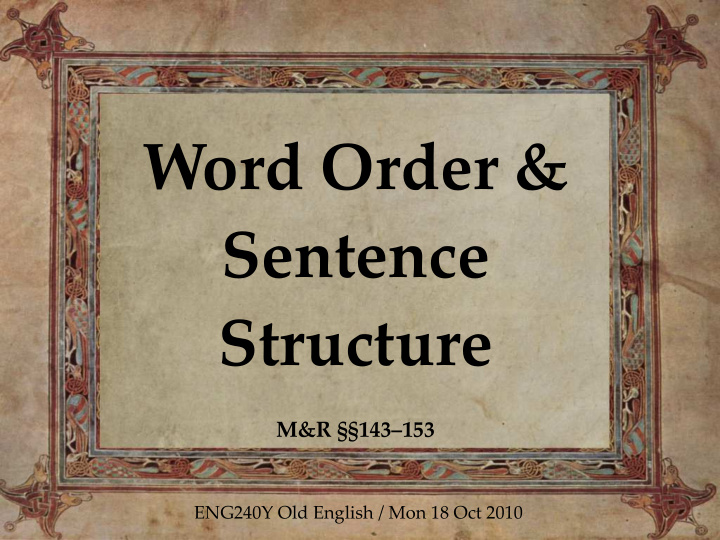



Word Order & Sentence Structure M&R §§143–153 ENG240Y Old English / Mon 18 Oct 2010
Word order in present-day English ● headclause: SVO Jack eats carrots. ● subclause: SVO I know [that Jack eats carrots]. I know [that Jack carrots eats]. adv + headclause: SVO Then Jack ate a carrot. Then ate Jack a carrot. ● adv + headclause: VS Then came the aftershock. - only with certain intransitive verbs Eat carrots! ● imperative: VO ● interrogative with to be : VS Why was he here? ● interrogative with aux .: vSV What have I done? In short: word order in positive statements is rigidly SVO, while interrogatives and imperatives start with the verb.
Word order in Old English Numerous constructions are valid. Here are some: God lufode Iācob. ● headclause SVO ● headclause VSO Wæs h ē Osrices sunu. ● headclause SOV Þ ū þæt cwǣde. Ic wāt [þæt þū mē gehȳrst]. ● subclause SOV Ðā slōg se wind þone lēg on þæt ● adv + headclause VSO hūs. Þā sēo fǣmne cwæð: … ● adv + headclause SV ● adv + headc. + prep. VSiO Þā cwæð se engel tō hyre: … ● adv + headcl + prep. ViOS Þā cwæð him hǣlend tō: ... On þǣre tīde cwæð Petrus “X”. ● prep. + headclause VSO On ðǣm dǣge hē gemētte āne ēa. ● prep. + headclause SVO Ic wāt [þæt hē inc ābolgen wyrð]. ● subclause SiOV Ic wāt [þæt ūs cymð se Mæssias]. ● subclause iOVS
Word order in Old English In summary: ● SVO is default in headclauses, but expect variations Hēo cūðe Godes ǣ. ● an initial adverb is often immediately followed by a verb Ðonne byrnð sēo eorðe. ● when a clause contains multiple verbs, the main verb occurs in (near-)final position Hē wolde hine tō deaðe gedōn. ● in subclauses, all verbs occur towards the end Hē arn þā tō þām hǣlende [þā hē hine gesēah]. [Þā hē hine slēan wolde] þā fēoll hē underbæc. ● Imperatives are V(S)(O), much like in Modern English Æt þisses ofetes! Wes þū on ofeste!
Sentence structure Note: ● the use of pronouns to recapitulate (“Mama she done told me”) ● the use of pronouns to anticipate Þæt mē is sorga mǣst, þæt Adam sceal mīnne stōl behealdan. ● the splitting of groups within a subject/object Her cōm Port on Brytene and his twēgan sunan.
Sentence structure Note: ● conjunction-adverb correlation Þonne wē sind gelāðode, þonne sind wē untīgede. Þā þā hē slēp ðā genam hē ān rib of his sīdan. NB contrast “ Þā andswaredon þā Iūdēas. ” (pronoun) þā ... þā “when ... then” þonne … þonne “when … then” þǣr ... þǣr “where ... there” þider ... þider “whither ... thither” gif ... þonne “if ... then” When in doubt, the clause with VS is nearly always the headclause.
Recommend
More recommend